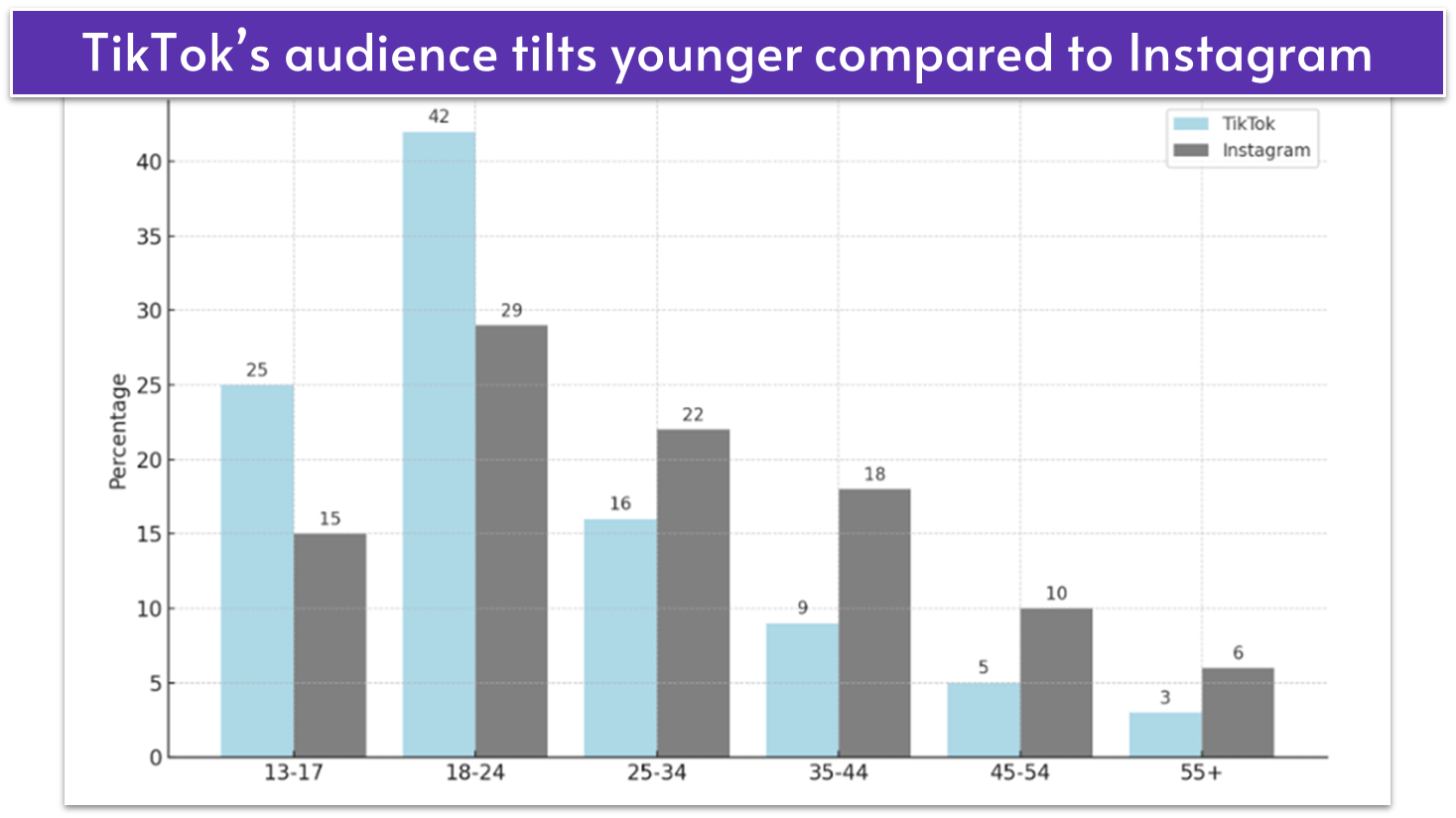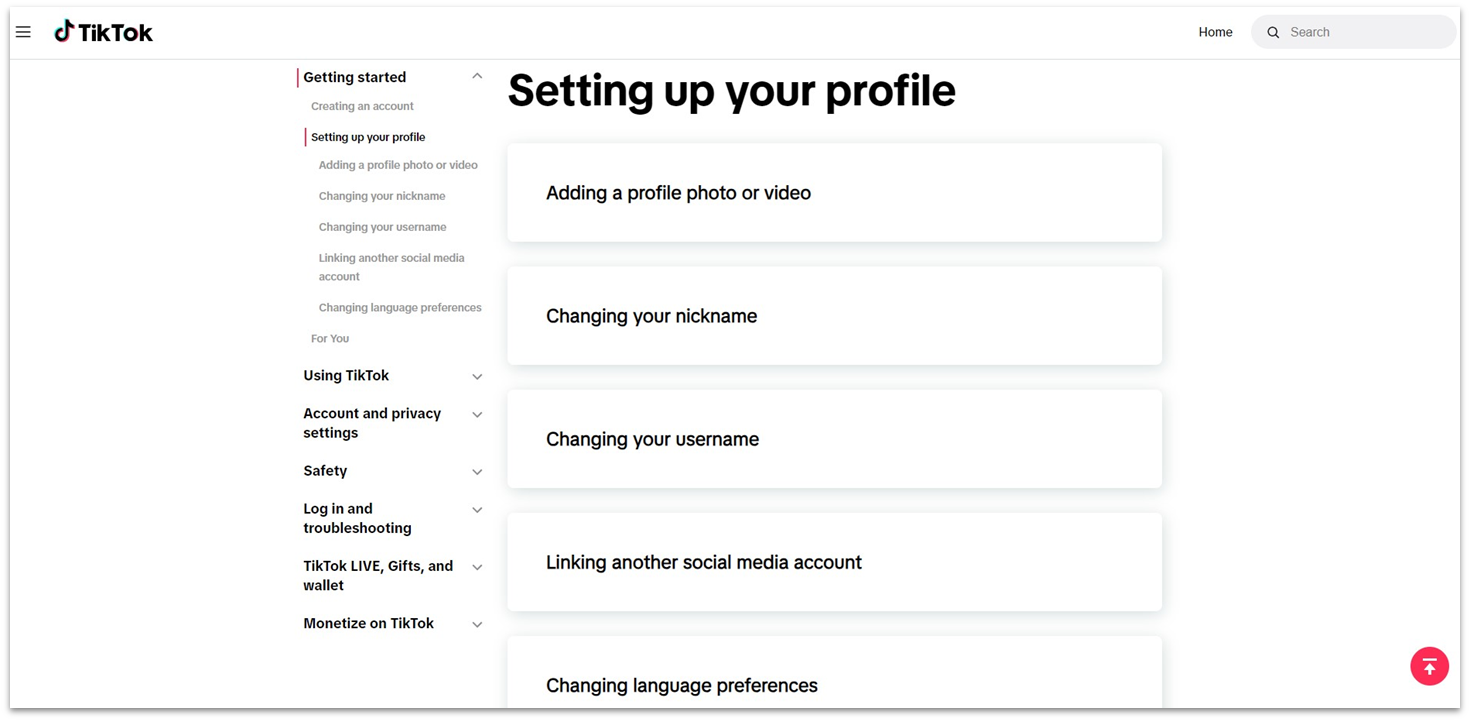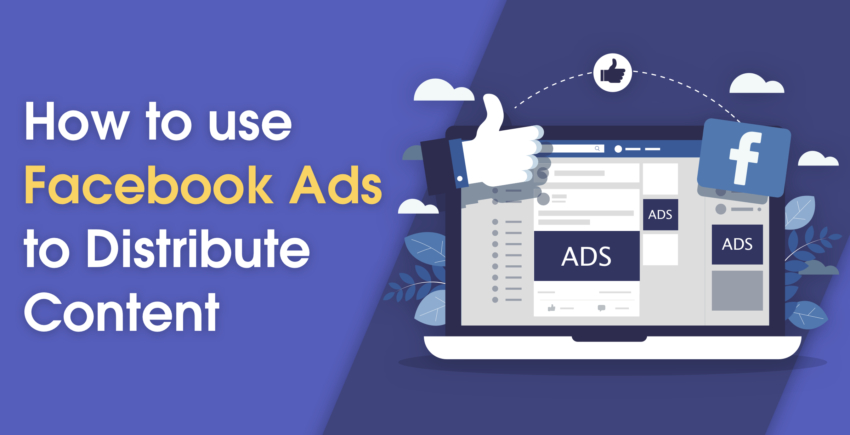Inside this Article
Features
Instagram Suits Established Brands; TikTok Benefits Small Businesses With Viral Potential
When deciding between TikTok and Instagram for your business, you must understand each platform’s unique features. While both platforms allow you to promote your business effortlessly, TikTok is ideal for brands targeting Gen Z, and Instagram lets you reach a broader demographic. TikTok and Instagram offer many features that allow businesses to share content and promote their brands. These include:Content Types
TikTok and Instagram both offer engaging content formats that you can use to promote your business or brand. TikTok content formats:- Short videos: Videos up to 3 minutes long for quick, engaging, and often viral content
- Duet: Collaborative video created alongside another user’s video
- Stitch: Clipped or integrated scenes from another user’s video you can use in your own
- LIVE: Real-time video content where creators interact with viewers directly
- Photos: High-quality single images or carousels (series of images)
- Videos: Posts in the main feed (up to 60 minutes) or Reels (up to 90 seconds)
- Stories: Temporary 24-hour content that can include images, videos, and various interactive elements like polls and quizzes
- Live: Live broadcasting to followers, often used for real-time engagement
- Reels: Quick, engaging videos set to music or other audio, similar to TikTok’s short videos
Algorithm
TikTok’s algorithm is uniquely designed to rapidly learn user preferences through likes, shares, and viewing time interactions. It makes it easy to push content to a broad audience through its For You page, regardless of the creator’s number of followers. This feature significantly levels the playing field, allowing new and smaller businesses to achieve visibility alongside more established ones.
While robust in its targeting capabilities, Instagram primarily boosts content from accounts users already follow, supplemented by recommendations based on past interactions. This approach favors accounts with larger followings or those who can invest heavily in paid promotions to maintain visibility.
Analytics
TikTok and Instagram provide valuable insights that can guide your content and advertising strategy, but Instagram provides more detailed analytics tools than TikTok. TikTok Analytics metrics:- Follower growth: Growth of your follower base over time
- Video views: Number of views your videos receive
- Profile views: Number of users who visit your profile
- Content performance: Performance of individual videos in terms of views, likes, shares, and comments
- Audience demographics: Insights into the demographics of your audience, including age, gender, and location
- Follower demographics: Detailed demographic information about your followers, including age, gender, and location
- Engagement metrics: Metrics such as likes, comments, and shares for individual posts
- Content reach: Post reach and impression tracking to understand your posts’ visibility
- Website referral traffic: Amount of traffic directed to your website from your Instagram profile
- Story analytics: Metrics related to your Instagram Stories, including views, replies, and exits.
Pro Tip: TikTok’s and Instagram’s native analytics allow you to track performance over a specific timeframe, but it’s capped at 90 days. For extended data and more customizable reporting options, you can use third-party social media tools for your business.
Social Marketing and Selling Tools
Both TikTok and Instagram provide tools for social commerce and advertising. To promote your products and get access to new customers, you can take advantage of some of these tools. TikTok for Business:- Auto Message: Welcome message or automated replies set up for customers.
- TikTok Ads Manager: Range of ad formats, including in-feed ads, branded effects, and hashtag challenges.
- TikTok Creator Marketplace: Influencer collaboration that enhances your reach through authentic, creator-driven content.
- E-commerce integration: Virtual storefront on TikTok, where followers can explore your products and purchase directly through the app.
- Instagram Insights: Comprehensive analytics tools to track engagement, reach, and the effectiveness of your posts and stories.
- Instagram Shopping: Product catalog integrated into your business profile so customers can purchase products through posts, stories, and the dedicated shop tab.
- Instagram Ads: Different post formats, such as photos, videos, and Stories, are turned into ads and target specific audience segments.
Ease of Use
Navigating TikTok Is Simpler Than Feature-Rich Instagram
TikTok and Instagram are fairly easy to use. Both websites adopt minimalistic designs so you can find your way around quickly. However, navigating Instagram can be overwhelming due to its content creation and analytics tools that support various content types, unlike TikTok, which primarily focuses on video content. Creating and switching to a business account on TikTok is straightforward, requiring just a few taps in the app settings. On the other hand, setting up an Instagram business account may take longer due to the extra optional opt-in/out slides, although you can skip them. Additionally, creating a shop on TikTok requires creating a separate seller account, whereas you can use the same business account to set up a shop on Instagram.
Audience Demographics
TikTok Skews Younger, While Instagram Appeals to a Broader Age Range
Both TikTok and Instagram have fairly young demographics. However, TikTok generally appeals more to a younger audience, with a significant portion of its user base under 30 and around 1.8 billion monthly active users globally (Business of Apps, 2024). This makes it an excellent platform for businesses targeting Gen Z and younger Millennials, particularly for industries like fashion, entertainment, and technology that resonate well with trends and viral content.
Ads and Pricing
TikTok Ads Can Be Cheaper Than Instagram
Both TikTok and Instagram offer various ad formats, but they differ significantly in terms of pricing and targeting options. TikTok ad formats include:- In-feed ads: Ads that appear on users’ For You pages, blending with organic content
- Branded effects: Custom filters, stickers, and effects that allow users to interact with your brand
- Branded hashtag challenges: Hashtag campaigns that encourage user-generated content and engagement
- Spark Ads: Organic posts turned into ads to gain more visibility

- Carousels: Multiple images or videos in a single ad
- Stories ads: Full-screen ads that appear between Stories
- Reels ads: Similar to TikTok’s in-feed ads but in Instagram’s Reels format

Support
TikTok Offers Superior Customer Support and Well-Organized Resources
TikTok generally offers superior customer support options for businesses compared to Instagram. The articles in TikTok’s Help Center are well-organized, making finding information on specific ad or business tools easy. Additionally, the extensive video tutorials and step-by-step guides simplify the app’s usage, even if you’re not tech-savvy.
TikTok vs Instagram: Which Is Better for Your Business?
After an exhaustive analysis of the features, algorithms, demographics, and content formats, I’ve concluded that the best platform for your business depends on your type of business and growth stage. Instagram is most suitable for your campaigns if your business is already established and you have a decent marketing budget. You’ll be able to design high-quality images and videos that appeal to all demographics. Best of all, if you have an e-commerce business or run a B2B enterprise, Instagram can be a great way to reach your customers. However, remember that you must have a large audience to make the best of Instagram for business. On the other hand, TikTok can work for all stages of business, especially if you’re a small business with few followers or a limited budget. Thanks to its algorithm that promotes organic content and its young and highly engaged audience, you can quickly go viral on TikTok. So, if you sell items that thrive on trends, such as clothing, electronics, and beauty products, expect to expand your customer base more rapidly using TikTok. Each platform has distinct strengths, so choose the one that best aligns with your business type and marketing goals.| TikTok | ||
| Content Length |
Short videos (15 – 60 seconds) | Photos and videos (1 – 15 minutes) |
| Focus | Short-form, entertaining videos | Photos and longer-form content |
| Sound | Often includes music and sound effects; music library with up to 10,000 commercial sounds |
Can include music, but not as common |
| Editing | Basic video editing tools available | More advanced editing tools available |
| Interaction | Likes, comments, shares, duets, interactive add-ons |
Likes, comments, shares, saves, broadcast channels |


![6 Top Social Media Analytics Tools for Starters & Marketers [2025]](https://dt2sdf0db8zob.cloudfront.net/wp-content/uploads/2024/05/SM-Best-850x446.jpg)




![Sprout Social vs. Hootsuite: Bigger Isn’t Always Better [2025]](https://dt2sdf0db8zob.cloudfront.net/wp-content/uploads/2019/08/Hootsuite-vs-Sprout-Social-850x435.jpg)
![Sprout Social vs. Hootsuite: Bigger Isn’t Always Better [2025]](https://dt2sdf0db8zob.cloudfront.net/wp-content/uploads/2019/03/Sharon-Hurley-Hall-WSP-bio-image-1.jpg)






